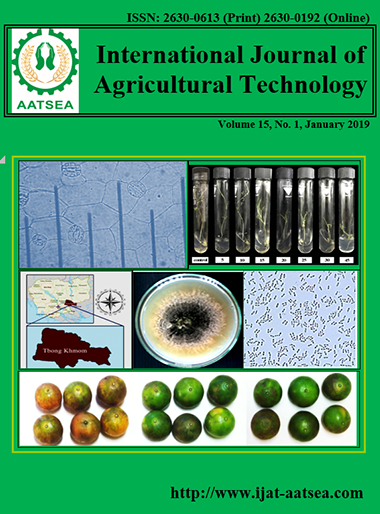Effect of canopy positions on physicochemical quality of Mandarin Fruit cv. ‘Shogun’ during Storages
Main Article Content
Abstract
The effect of canopy positions (upper, middle and lower) on quality of mandarin fruit cv. ‘Shogun’ stored at 20°C and 10°Cwas investigated. The results showed that the canopy positions influenced the appearance and peel colour which the peel of fruits from the upper part had more yellow and chroma value than the fruits from middle and lower parts which the peel had more green colour. The canopy positions had no influenced on the fruit pulp colour. The fruits from the upper part had total soluble solids (TSS), antioxidant activity (AA), ascorbic acid (AsA), total phenols (TP) and total flavonoids (TF) contents higher than the fruits from middle and the lower parts whilst total acidity (TA) of the fruits from different canopy positions was similar. During storage, most physicochemical quality attributes seemed constant, except TA which decreased on day 7 and antioxidant activity of the fruits stored at 10 °C which decreased on day 21. In conclusion, the canopy positions had influenced on ‘Shogun’ mandarin fruit quality which the fruits from the upper part had quality higher than the fruits from middle and lower parts.
Article Details

This work is licensed under a Creative Commons Attribution-NonCommercial-NoDerivatives 4.0 International License.
References
A. O. A. C. (1990). Official Methods of Analysis. 16th Edition. Association of Official Analytical Chemists International, Washington, DC. pp. 1141.
Awad, A. M., Wagenmakers, P. S. and de Jager, A. (2001). Effects of light on flavonoid and chlorogenic acid level in the skin of ‘Jonagold’ apple. Scientia Horticulturae. 88:289-298.
Benzie, I. F. F. and Strain, J. J. (1996). The ferric reducing ability of plasma (FRAP) as a measure of “Antioxidant power”: the FRAP assay. Analytical Biocheistry. 239:70-76.
Chelong, I. and Sdoodee, S. (2012). Pollen viability, pollen germination and pollen tube growth of Shogun (Citrus reticulate Blanco) under climate variability in southern Thailand. Journal of Agricultural and Technology. 8:2297-2307.
Chelong. I, and Sdoodee, S. (2013). Effect of climate variability and degree-day on development, yield and quality of shogun (Citrus reticulate Blanco) in southern Thailand. Kasetsart Journal (Natural Science). 47:333-314.
Daito, H., Tominaga, S., Ono, S. and Morinaga, K. (1981). Yield of differently trained trees and fruit quality at various locations within canopies of differently trained Satsuma mandarin trees. Journal of the Japanese Society of Horticultural Science. 50:131-142.
Drogoudi, P. D. and Pantelidis, G. (2011). Effects of position on canopy and harvest time on fruit physico-chemical and antioxidant properties in different apple cultivars. Scientia Horticulturae. 129:752-760.
Dorji, K. and Yapwattanaphun, C. (2011). Assessment of morphological diversity for local mandarin (Citrus reticulate Blanco) accession in Bhutan. Journal of Agricultural Technology. 7:485-495.
Feng, F., Li, M., Ma, F. and Cheng, L. (2014). Effects of location within the tree canopy on carbohydrates, organic acids, amino acids and phenolic compounds in the fruit peel and flesh from three apple (Malus x domestica) cultivars. Horticulture Research. 1:14-19. Retrieved from doi:10.1038/hortres.2014.19.
Hashimoto, S. and Yamafuji, K. (2001). The determination of diketo-L-gulonic acid, dehydro-L-ascorbic acid, and L-ascorbic acid in the same tissue extract by 2, 4-dinitrophenol hydrazine method. The Journal of Biological Chemistry. 147:201-208.
Jakopic, J., Stampar, F. and Verberic, R. (2009). The influence of exposure to light on the phenolic content of ‘Fuji’ apple. Scientia Horticulturae. 123:234-239.
Jia, Z., Tang, M. and Wu, J. (1999). The determination of flavonoid contents in mulberry and their scavenging effects on superoxide radical. Food Chemistry. 64:555-559.
Krishnaprakash, M. S., Arvindaprasad, B., Krishnaprasad, C.A., Narasimham, P., Anathakrishna, S. M., Dhanaraj, S. and Govindarajan, V. S. (1983). Effect of apple position on the tree on maturity and quality. Journal of Horticultural Science. 58:31-36.
Lewallen, K. S. and Marini, R. P. (2003). Relationship between flesh firmness and ground color in peach as influenced by light and canopy position. Journal of the American Society for Horticultural Science. 128:163-170.
Marini, R. P., Sowers, D. and Marini, M. C. (1991). Peach fruit quality is affected by shade during final swell of fruit growth. . Journal of the American Society for Horticultural Science. 116:383-389.
Moon, D., Joa, J., Moon, Y., Seong, K., Kim, C. and Ahn, Y. (2011). Plant growth and fruit quality as affected by canopy locations in ‘Shiranuhi’ mandarin. Horticulture Environment and Biotechnology. 52:443-447.
Randhir, R., Lin, Y. T. and Shetty, K. (2004). Stimulation of phenolics, antioxidant and antimicrobial activities in dark germinated mung bean sprouts in response to peptide and phytochemical elicitor. Process Biochemistry. 39:637-646.
Slinkard, K. and Singleton, V. L. (1977). Total phenol analysis: automation and comparison with manual methods. American Journal of Enology and Viticulture. 28:49-55.
Unuk, T., Tijskens, L., Germšek, B., Zadravec. P., Vogrin, A., Hribar, J., Simčič, M. and Tojnko, S. (2012). Effect of location in the canopy on the colour development of three apple cultivars during growth. Journal of the Science of Food and Agriculture. 92:2450-2458.
Yakushiji, H., Morinaga, K. and Nonami, H. (1998). Sugar accumulation and partitioning in satsuma mandarin tree tissues and fruit in response to drought stress. . Journal of the American Society for Horticultural Science. 123:719-726.


